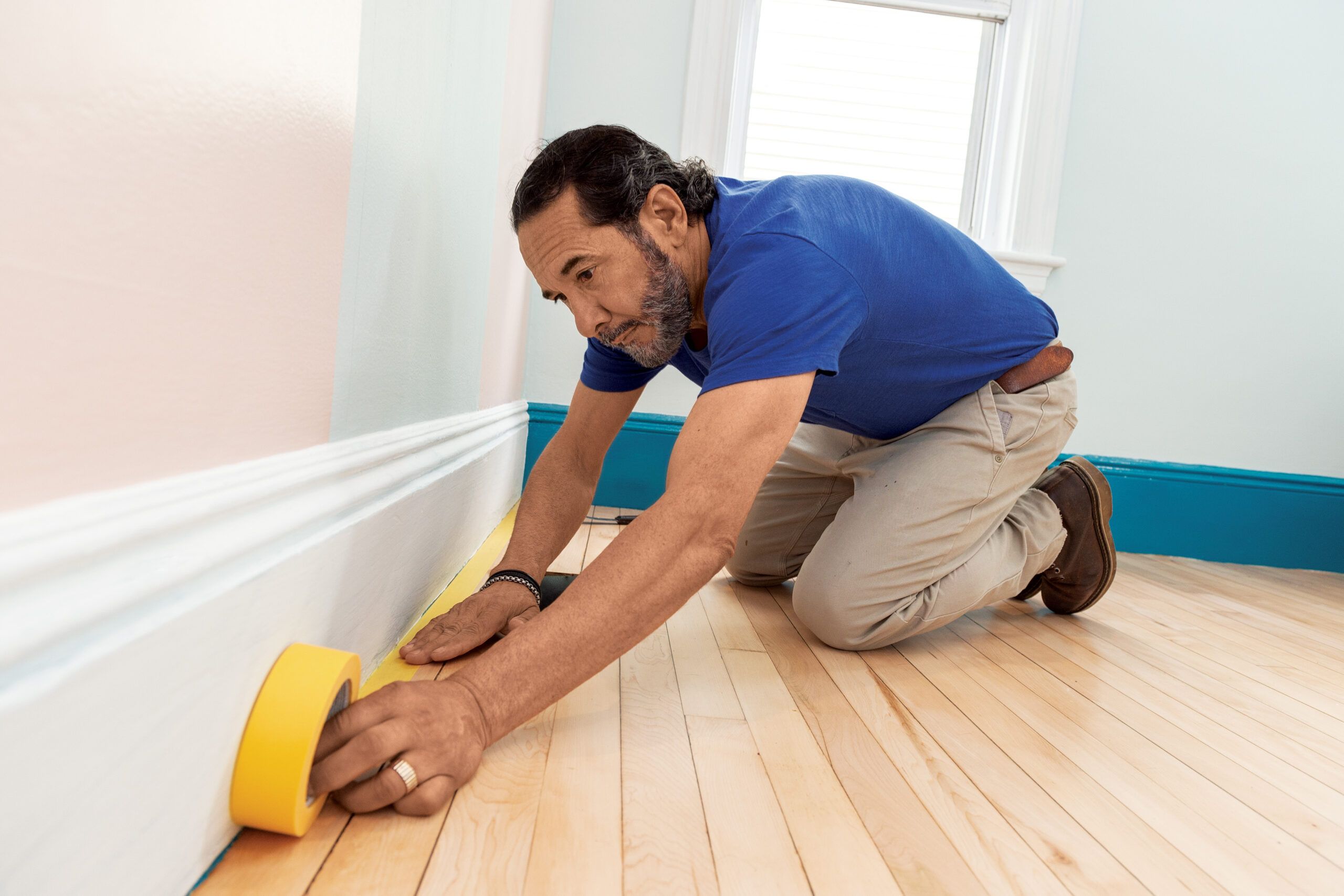It may seem like a straightforward task, but achieving a professional-looking paint job requires skill, patience, and the right tools. Below, we explore expert tips and best practices for interior painting, drawing from the wisdom of seasoned This Old House paint professional Mauro Henrique.
“Probably 85% of any painting project is the preparation. Filling holes, sanding, caulking gaps, and other prep work takes time, but it’s essential to a good paint job. If you start with a well-prepared surface, with some practice, you can master the other 15%” — Mauro Henrique, This Old House painter
How To Prep a Room for Paint

- Remove hardware: Take off window locks and lifts, doorknobs and strikes, electrical cover plates, and light fixtures. Tape the screws to each piece of hardware and label its location. Store the items together in a bucket—this makes reinstalling them easier later on.
- Clear out obstacles: Whenever possible, relocate furniture to another room so that you can easily navigate the space where you’ll paint. Cover whatever can’t be removed with plastic sheeting, and clear a pathway that’s at least 3 feet wide.
- Protect floors: Pros generally avoid using painter’s tape—it’s time-consuming to apply. One place Henrique always tapes, though, is along the bottom of baseboards. He then tapes a wide border of rosin paper to this strip of tape and covers the rest of the floor with plastic-lined canvas drop cloths. These prevent any spilled paint from seeping through.
- Fill holes, gaps, and cracks: Closely inspect walls and trim for imperfections. Patch holes, dents, and dings by using ready-mix spackle on walls or wood filler on trim. On plaster walls, Henrique uses joint compound and mesh tape on wide cracks and flexible patching compound on smaller ones. Fill gaps around the trim by cutting a caulk tube close to the tip and running a small bead, pressing down and pulling the caulk gun toward you as you work. Then, run a wet finger on it to smooth it out.
- Sand and remove dust: To create a smooth, even surface for painting, scuff-sand moldings, doors, and windows with 220-grit paper. Use a pole sander with 120-grit paper to smooth walls. If you’re working on paint that could be more than 45 years old, test for lead first. Thoroughly remove sanding dust with a vacuum equipped with a HEPA filter, followed by a damp rag or tack cloth.
Pro tip: Don’t over-caulk gaps. Cutting the tip of the tube too big results in messy joints. Measure the gap, and use a caulk tube that’s marked with lines indicating where to cut depending on the size of the gap. Or, start small near the end of the tip and adjust as needed.
Choosing the Best Primer
Primer isn’t always necessary, such as when you’re recoating walls and trim that are in good condition and were previously covered in a similar shade and formulation. But with new drywall and fresh plaster, primer is essential to seal the surface. If you’re applying a light color over a dark one, the previous paint job is damaged or deteriorated, or you’re coating a porous or slick surface, using an appropriate primer will ensure optimal coverage.
Here are our recommendations for common surfaces:
- Walls: A general purpose, water-based, 100% latex formula should do the trick here. If you’re making a big color change, ask your paint store to tint the primer to ensure even coverage.
- Bare wood trim: Henrique relies on oil-based primer for this: “It fills and seals the pores so that whatever paint you use will adhere well.”
- Painted wood trim: For trim previously painted with latex, a water-based latex primer is fine. But if you’re unsure what type of paint was used, you may want to use one that’s oil-based.
- Clear-coated wood trim: If the trim has a coat of polyurethane or varnish, shellac primer will provide the best adhesion. Since both oil-based and shellac primers give off volatile organic compounds (VOCs), which can damage your lungs, be sure to work in a well-ventilated space.
- MDF: For medium-density fiberboard moldings or built-ins, choose shellac- or oil-based primer. Water-based formulas can cause the material to swell and crumble.
- Masonry: Got an exposed brick wall or chimney indoors? Seal the pores with a water-based latex primer.
- Metal: Use an oil-based primer on ferrous metals that contain iron to prevent rust and a water-based latex metal primer on nonferrous surfaces.
- Plastic: If you’re painting laminate, go with a bonding primer, a modified acrylic formulation made to adhere to slick surfaces.
Must-Have Painting Tools
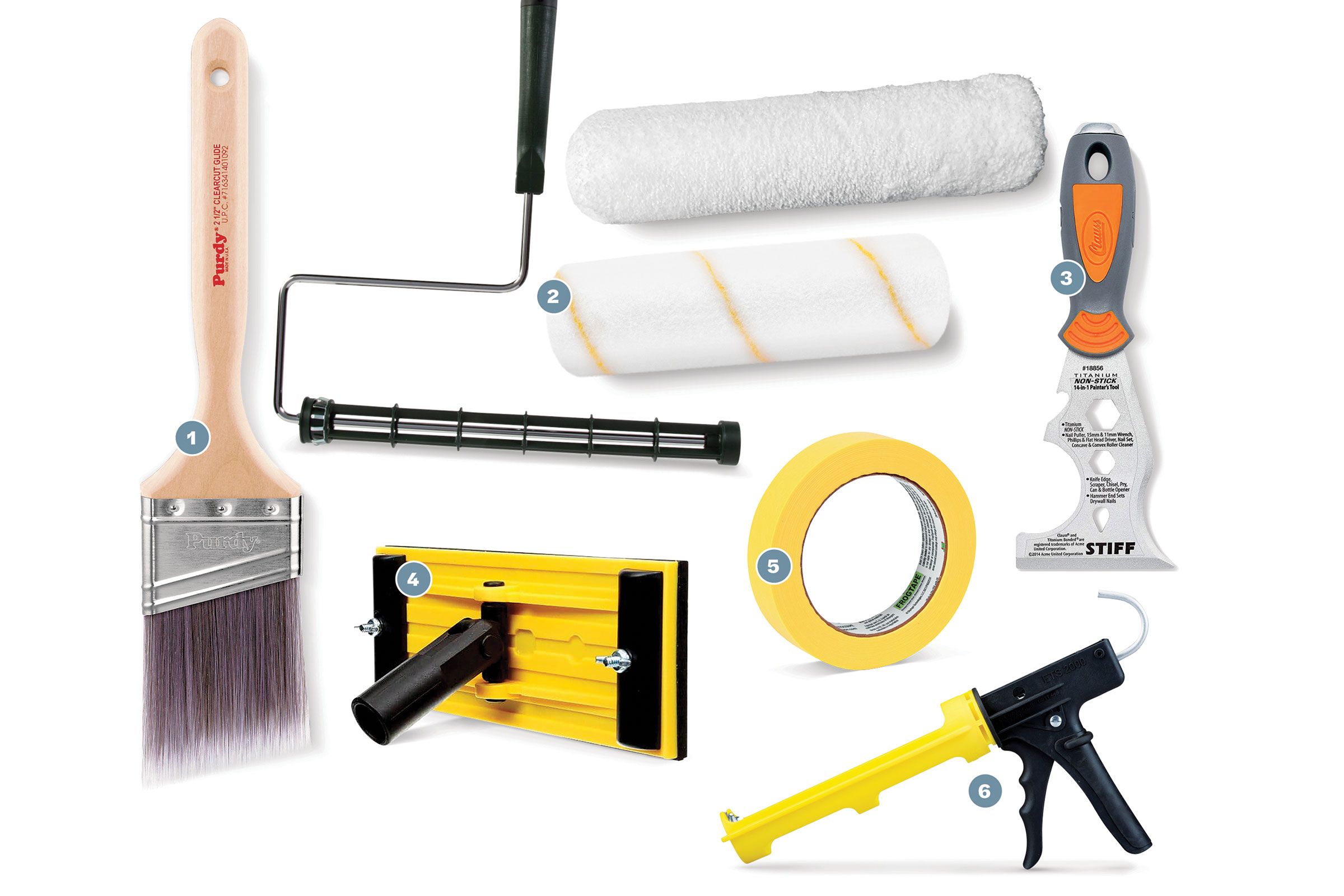
- Paintbrushes: For latex paints, brushes with synthetic bristles are Henrique’s choice, particularly a 2 1/2-inch angled sash brush for cutting in. For detail work, he likes a 1 1/2-inch sash brush, and to cover large, flat areas, a 3-inch straight brush. He uses natural hog hair brushes with oil-based paints and disposable foam brushes for one-time touch-ups.
- Paint roller and roller covers: Henrique relies on lint-free microfiber covers. He chooses from three naps: 1/4 inch for smooth surfaces, 3⁄8 inch for semirough surfaces (most common indoors), and 1 inch for textured surfaces. Starting with a sturdy roller frame, he adds a screw-in extension pole for coating ceilings and other hard-to-reach areas.
- Painter’s tool: Professional painters use this classic multi-tool for scraping out joints, cutting tape, prying open cans, cleaning roller covers, and more.
- Pole sander: A sanding head fitted with 120-grit sandpaper and a pole smooths walls for painting. “Sweep the sander side to side as you work your way from the top down,” Henrique advises.
- Painter’s tape: To mask off finished surfaces, such as floors, Henrique uses low-tack painter’s tape. He burnishes the edge with a putty knife to ensure there’s no bleed-through.
- Caulk gun: Henrique prefers a manual gun that has a built-in tip cutter and a hinged steel pin for puncturing the seal on a tube of good-quality, paintable white acrylic caulk.
Pro tip: “Always buy top-of-the-line paint. It costs a little more per gallon, but it goes on better, looks better, and gives you a more durable finish,” Henrique says.
Make a Plan: What To Paint When
Following a logical order for any paint project does matter, Henrique says. “It saves time and protects your work. You won’t be brushing up against or dripping paint on wet surfaces, so you won’t have to redo them.” His general approach is to work top to bottom, left to right.
1. Start with the ceiling: First, paint a band three inches wide along the perimeter with an angled sash brush, then use a roller on an extension pole to cover the broad expanses. Do two coats.
2. Paint the trim, windows, and doors: Tackle crown molding first, followed by windows and their casings, then doors and their casings. If you have the space, remove doors to another work area where you can lay them flat and paint them while the rest of room is drying. Finish by painting any wall paneling or other trim.
3. Cut in and roll the walls: With much of the detail work out of the way, you can paint the walls. This is an opportunity to create a crisp border with previously painted surfaces if the line is uneven.
4. Paint baseboards last: Since you’re working with gravity, any fallen paint droplets that you missed cleaning up can be addressed now. Start by cutting in along the top of the molding, then work your way down to the floor.
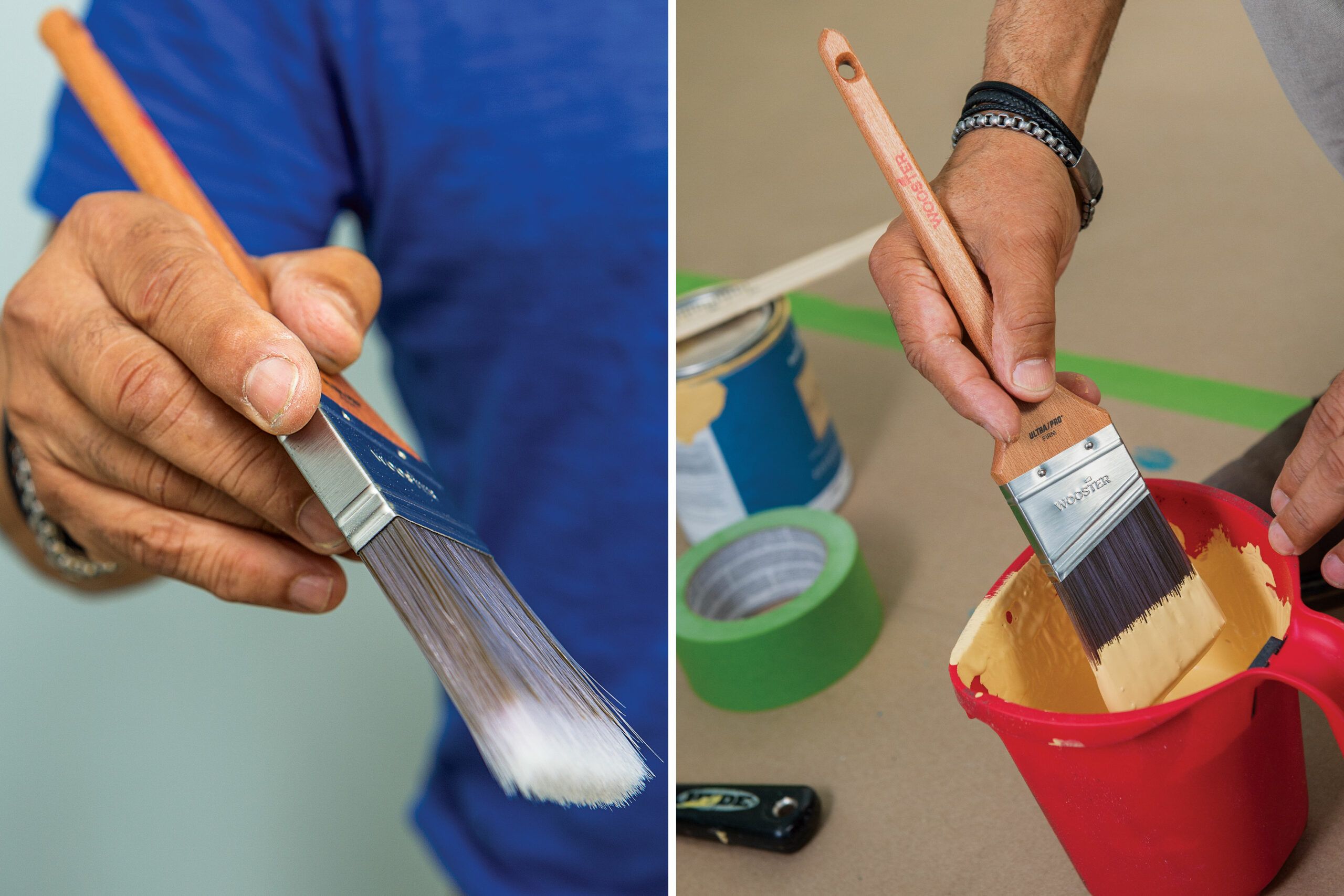
How To Hold a Paintbrush
The right grip allows you to control the flow of paint. Start by holding the brush like a pencil, with your index finger touching the ferrule along the narrow edge, your thumb on one side, and your remaining three fingers on the other. This works well when cutting in. “But it’s OK to adjust your grip as you go, depending on what you’re doing,” says Henrique. “It helps fight hand fatigue.”
How To Load a Paintbrush
Never dip your brush into a can of paint. “You risk contaminating the whole can if debris or dust gets in,” says Henrique. Always pour paint into a small paint pail, filling it about halfway. “To load the brush, dip the bristles into the paint about the width of two fingers,” he says. “This prevents dripping, and it also prevents you from having to clean the entire brush when you’re done, which saves time.” Tap it lightly against the side of your bucket to work the paint into the bristles and remove any excess.
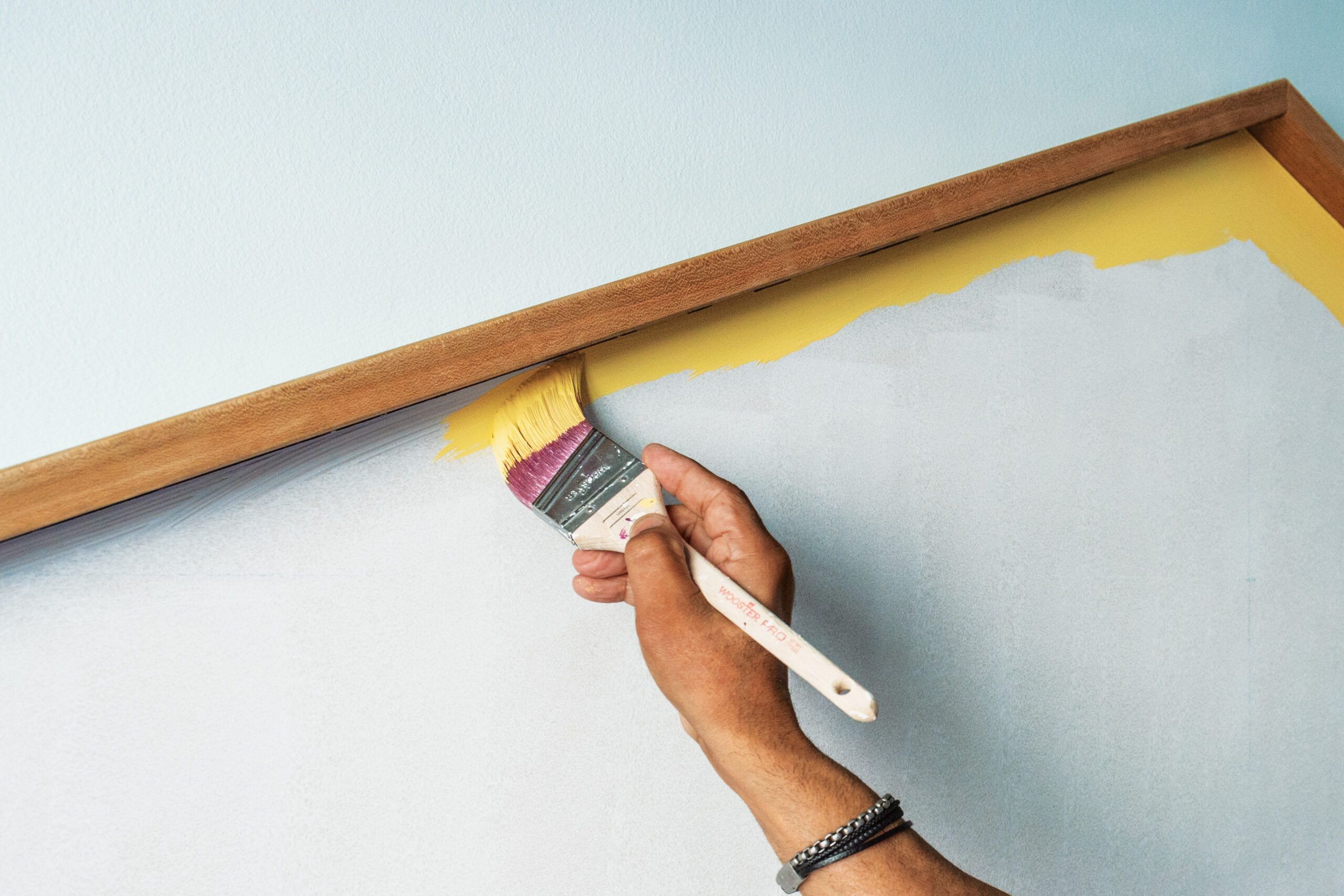
How To Roll Paint on a Wall
Moderate, even pressure is the key to smooth, even coverage. Fill the paint tray’s reservoir below the ridges. Dip the roller cover in, then distribute the paint evenly by rolling the cover over the ridges. “If the roller is covered with paint, you have enough,” says Henrique. “It shouldn’t be dripping.”
Starting near the top, at the edge of the cut-in area, place the roller flat on the wall. Roll on the paint in a W shape, overlapping the previous stroke a bit as you fill in the gaps. Don’t press too hard or try to stretch the paint toward the end. This causes ridges to form. Focus on applying a smooth, even coat, working in a 3-foot-square area.
When you’ve covered the wall, run a lightly loaded roller along the perimeter to blend in the texture of the brushstrokes you made while cutting in.
Let the walls dry for about 90 minutes, then repeat the cutting in and rolling sequence to apply a full second coat.
Pro tip: Make a custom-fit disposable paint tray liner with aluminum foil. Buy a roll that will cover the full width of the tray, up the sides, and around the edges. Carefully press down a foil sheet so that it conforms to the contours of the tray and won’t shift around. When you’re done, you can peel it off and toss it.
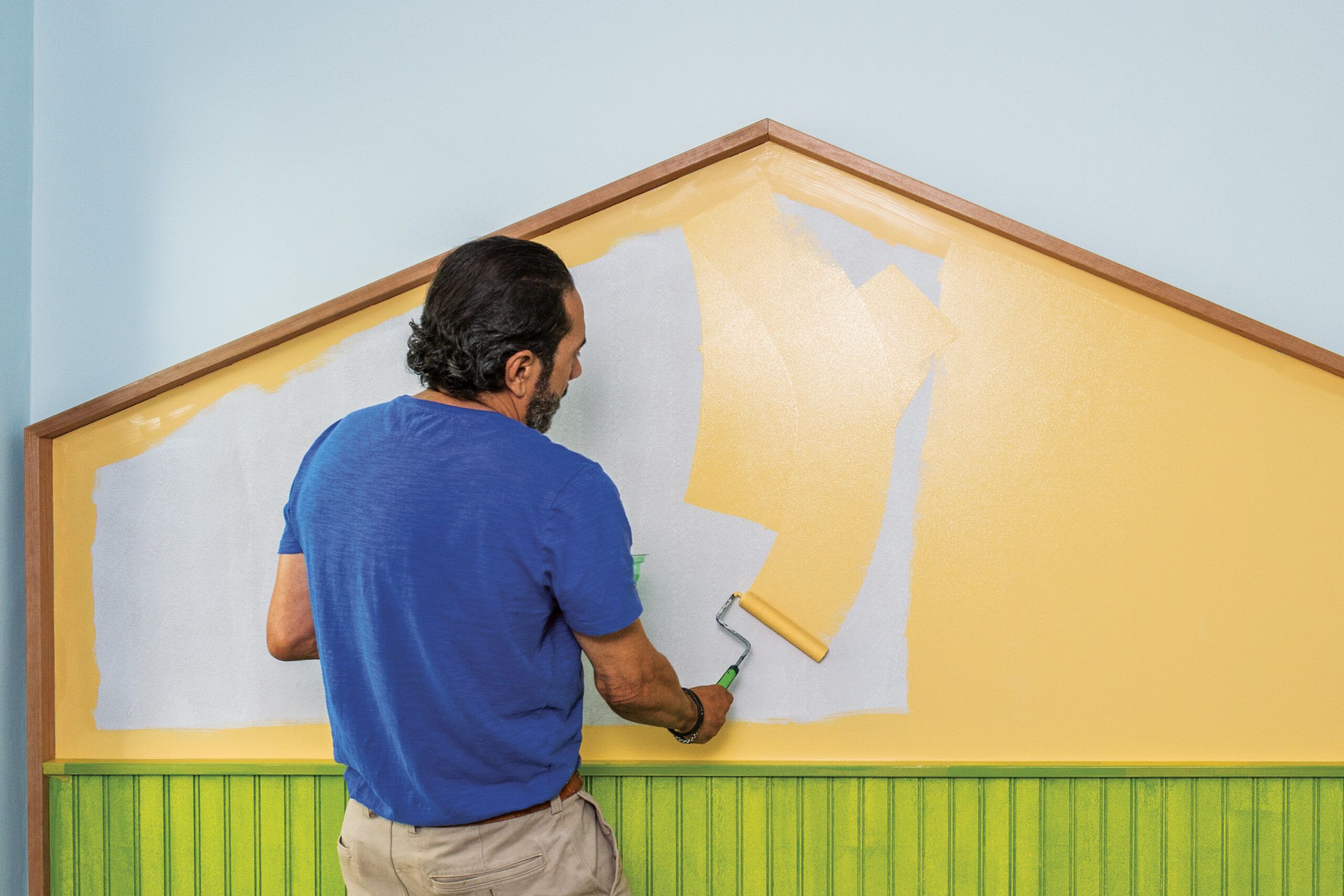
A Quick Guide to Paint Finishes
Paint comes in a variety of light-reflecting sheens. Here’s how Henrique approaches which one to use where.
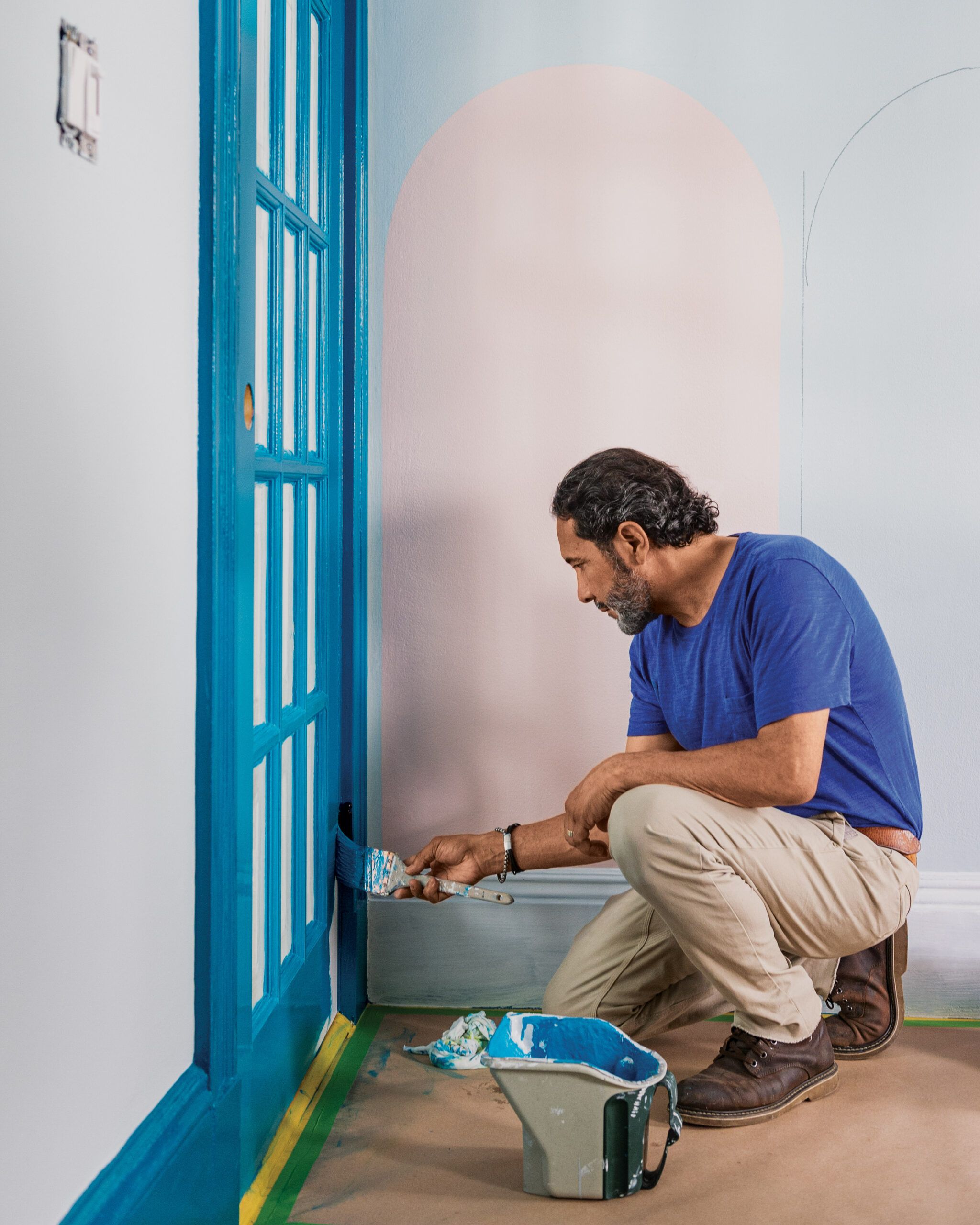
- Flat: This is the lowest sheen, which means the paint soaks up the available light. “It’s ideal for no-traffic areas like ceilings and hides surface imperfections.”
- Matte: Matte is a slightly reflective sheen that’s a bit more durable and hides minor imperfections. While not as washable as paints with more sheen, it takes touch-ups better if the painted surface gets scuffed later on. It’s good for low-to-moderate-traffic areas such as bedrooms.
- Eggshell: It’s a soft, velvety sheen with a bit more luster than matte paint, more stain resistance, and more washability. “It lends itself to areas with moderate to high traffic, such as kitchens, bathrooms, and hallways, where durability is essential.”
- Satin: Satin is a glossier sheen with a pearl-like appearance. It’s easy to clean, so it is well-suited for cabinets.
- Semigloss: This one has a sleek, radiant sheen that’s scrubbable. It’s Henrique’s choice for trim, doors, and playrooms.
- High gloss: It has a brilliant shine with a glassy sheen. He uses it to add vibrancy to entry doors, accent walls, or ceilings.
How To Paint a Straight Edge Without Painter’s Tape
Sometimes painter’s tape just isn’t an option. Maybe a side casing is too close to an inside corner, or you’re painting the outside edge of a window sash. In these cases, Henrique uses a wide putty or taping knife as a guide. Here’s how:
- Holding the blade between your thumb and remaining fingers, place it along the edge you want to paint. Grip it firmly, but make sure you can slide it.
- Touch the bristles of the paintbrush to the surface in front of the knife and slowly drag both hands down the joint at the same pace.
- Stop when paint starts to accumulate on the blade. Carefully lift it straight off to keep paint from bleeding onto the adjacent surface. Wipe the blade clean.
- Continue down the joint in the same manner. Once you reach the end, flip the brush over and paint in the opposite direction to smooth out your brushstrokes.
Painting Clean-Up Tips
Take the time to carefully remove protective coverings and thoroughly clean the tools you’ve invested in.
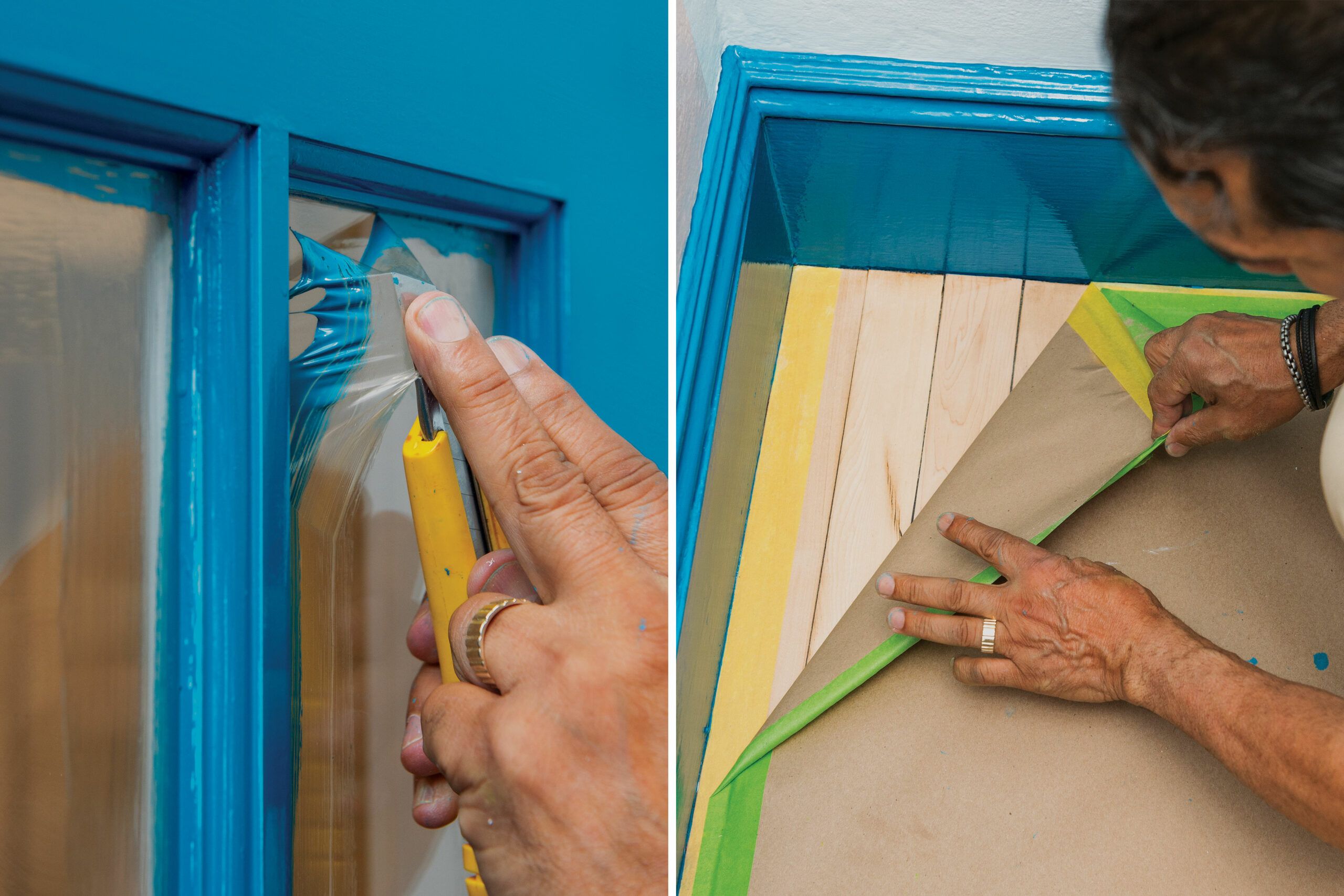
- Remove dried masking liquid: First, make sure paint is dry—it’s best to allow 90 minutes. You don’t want the paint to peel off along with the protective barrier. Use a utility blade to score the mask along the edges of the glass, then lift it off in one piece.
- Pull up painter’s tape: Once paint is dry, carefully pull off painter’s tape at a 45-degree angle to keep from taking paint with it. If the edge is sealed with paint, score along the paint line with a putty knife first.
- Clean paintbrushes: To get rid of latex paint, run the brush under warm water with the bristles pointed down. Use your fingers to work a few drops of dish detergent into the bristles, keeping water away from the ferrule. Press bristles up against the sink wall and scrub off any stuck-on paint with a plastic or nylon scrub pad. Avoid aggressive metal combs and brushes. They can damage the bristles. To clean off oil-based paint, swirl the bristles in odorless mineral spirits.
- Remove excess moisture with paper towels, then spin the brush handle between your palms: Never place wet brushes in a container with the tips up, where moisture can seep into the metal and cause it to rust. Lay brushes flat or hang them on a hook to dry, then store them in their original sleeve to keep the bristles in shape.
- Clean paint-roller covers: First, run the curved blade of a 5-in-1 tool down the cover to remove the paint. With latex paints, pull the cover halfway off the frame and run it under warm water, using a hand to push the paint out of the fibers. With oil-based paint, pour solvent into a paint tray and dip and roll the cover in the tray a few times; replace with clean solvent for a final rinse. Blot the cover with paper towel, and stand it on end to dry.
